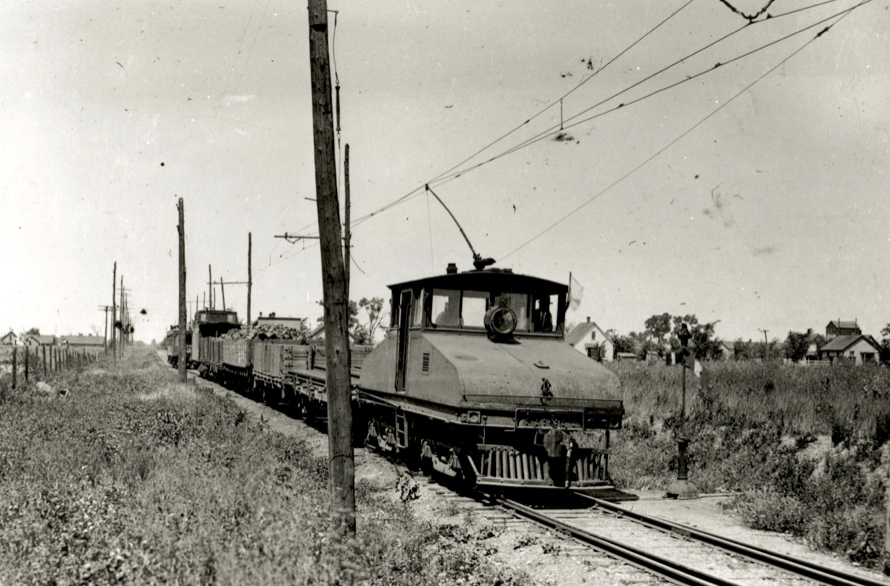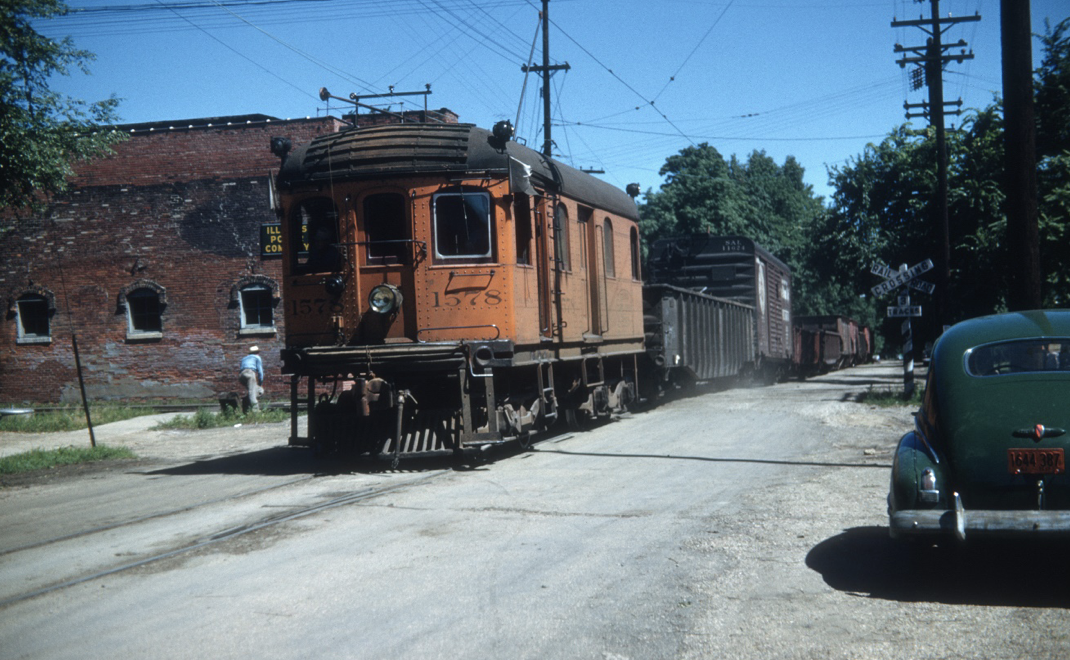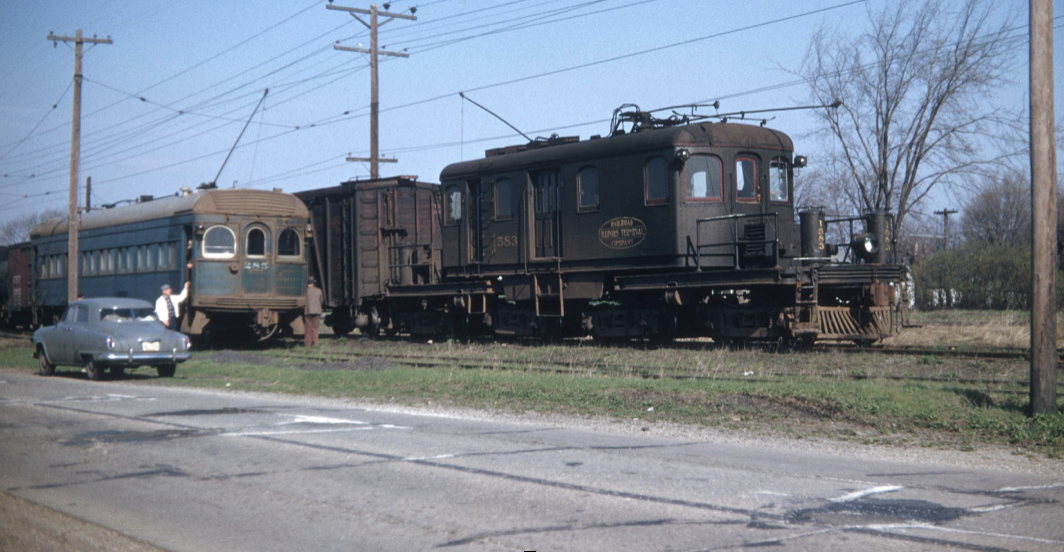| Illinois Traction System | |
|---|---|
| Text and captions by Art Peterson. All photos from the Krambles-Peterson Archives | |
|
What would become the 555-mile Illinois Traction System was incorporated in 1904. Starting from a line building west out of Danville, IL, the system eventually grew to have lines to Springfield (via Champaign-Urbana and Decatur) and from Springfield to St. Louis, as well as lines linking Springfield to Peoria and Decatur (via Bloomington) to the Peoria line at Mackinaw. Freight traffic steadily grew in importance for the IT (which adopted the Illinois Terminal name from 1928), and this article summarizes the development of electric freight locomotives on the IT. The September 3, 1910 issue of the Electric Railway Journal (ERJ) reported that ITs gross income from its interurban operations (freight and passenger combined) had increased from $1.6 million in 1907 to $2.0 million in 1908. A new line was being opened to allow IT to tap into the Grape Creek Coal District near Danville. In addition, the road was in the process of adding 50 new coal cars and 25 box cars to its fleet. IT set to work on the design and construction of a beefier engine. The Class Bs were designed by IT and built in the roads Decatur Shops. Six (out of what would eventually number 18 locomotives) were built and in service by the time the October 8, 1910 issue of the ERJ was out. The Journal reported that the Class Bs had drawbar pull of 30,000 pounds, with a 60-ton locomotive weight. Four GE69C motors, each producing 200 HP were accommodated in a pair of ALCO built trucks on the Class B locomotives. Gross revenue from freight traffic for the IT totaled more than $600 thousand in 1910. IT was transporting 2,000 tons of coal on an average day, in addition to carrying another 700 tons per day to its power plants. Also increasing in importance was transport of milk and other dairy products, which totaled 300 cars per day. Freight traffic demands continued to grow, necessitating still-bigger locomotives. IT again relied on its in-house mechanical design and shop forces to produce the twenty Class C locomotives, which were built at Decatur between 1924 and 1930. The bulk of these each produced 1,000 HP (three were rated at 900 HP). Eight GE 73C motors were used in a four-truck, articulated-design locomotive which had a total weight of 160,000 pounds. St. Louis 62 trucks were employed on the Class C locomotives. ERJs November 13, 1926 issue reported that IT freight revenue for 1924 (year ending April 30) had been $1.7 million, while for the same period in 1926, it had totaled $2.2 million. With just 11 of the Class Cs built and in service by the time of that article, IT indicated it was hauling 23% more business than it had before the big engines arrived. Speed of train operation and miles per car increased accordingly. In 1924 ITs freight car miles had been 7.0 million, while in 1925 they increased to 9.1 million. IT noted that it had hauled 269,673 tons of coal out of the Gillespie Mine alone for the year ended April 30, 1926 and that it served 43 on-line grain elevators. IT continued to advance electric locomotive design, selecting five of the Class C locomotives to be converted to streamlined, Class D locomotives in between 1940 and 1942. HP per locomotive was increased to 1,800, using eight WH 571FD1 motors. These traction motors had been developed for use on the New York City subway. The cab and the articulated frame of the Class C locomotives were re-used in the Class D locomotives; everything else on the locomotives were new. Double trolley poles were provided on each end of the Class Ds. These were provided to assist with higher-tonnage trains and to reduce instances of burning the trolley shoes and the wire. In addition, the double-pole arrangement helped at section insulators by bridging the insulator and avoiding the loss of tractive effort. <> With all five of the Class D locomotives in service by 1942, the road continued to report increasing freight traffic. For the roads 1948 Annual Report, it was noted that freight revenues were $1.5 million, an increase of 16% over the 1947 results. Although the postwar period was one of increasing labor unrest, which affected total freight traffic, IT could report continual increases in the gross ton-miles per train-hour, posting nearly a 4% gain in 1951 and an 8% increase in this parameter for 1952. <> However, the end was in sight for electric freight service on the IT. Six GP7s arrived during 1953, followed by 12 SW1200s in December 1955. The final electrified freight assignment saw Class B 1570 handling local switching duties in Morton, which ended on January 10, 1956. XX |
|
 XX |
 Thirty years earlier this locomotive handled the 1922 Indianapolis Special which had been displayed at the convention of the American Electric Railway Association. The 1578 took coach 531, 10 Section sleeper Edwardsville and the Parlor-Observation Clinton to and from Indianapolis. The special operated on its home rails to Danville and then was hauled 41 miles by the Big Four to Crawfordsville, where it could continue its electrified journey on the rails of the Terre Haute Indianapolis & Eastern. XX |
 Trailing the 1583 is one of ITs interchange box cars. Although IT had been aggressive on freight belt line construction, there were still sharp curves on some of its lines that had to be negotiated. To handle this, IT equipped its cars with then-standard ARA couplers which had additional side clearance to handle the tight-radius curves. Longer side bearings were also provided. In the mid-20s, IT had 310 interchange box-cars so equipped. XX |
 XX |
|
Acknowledgements: |
|
| New: 1 October 2023 | |